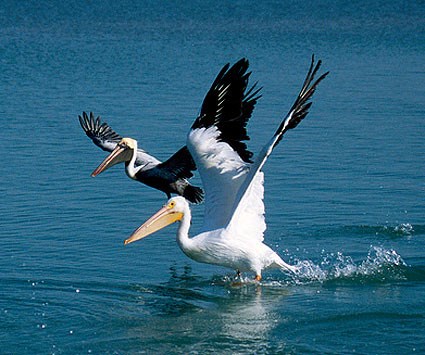When the Atlanta Thrashers packed their sweaty skates and headed to Winnipeg to become the Jets in 2011, the Bird-Named Big 4 Sports Team Club was down a member. Last year 11 of the Big Four teams ran behind a flapping mascot:
- NBA's Atlanta Hawks
- NFL's Baltimore Ravens, Philadelphia Eagles, Atlanta Falcons, Arizona Cardinals, and Seattle Seahawks
- NHL's Pittsburgh Penguins and Anaheim Ducks (I don't count the Chicago Blackhawks, who were named for a leader of the Sauk tribe, or the Detroit Red Wings, who were apparently named after a Montreal Cycling Club), and
- MLB's St. Louis Cardinals, Baltimore Orioles and Toronto Blue Jays
Much to my surprise, though, events conspired over the NBA winter to restore the club membership to an even dozen. Back in 2002, the under-attended Charlotte Hornets shipped their franchise to New Orleans. Just two years later, however, all was apparently forgotten and Charlotte unveiled a new basketball squad, the Bobcats. Well, the Bobcats suck, and worked a deal with New Orleans to bring the Hornets name back to Charlotte, where people still hardly give a crap.
That left the New Orleans team nameless, and after contemplating Mosquitoes (haha ok), Swamp Dogs (ughhhh), Bullsharks (cool) and Rougarou (what), the team owner went with the New Orleans Pelicans.
Fantastic! I love this for so many reasons. First, as I've said before, I just associate
Brown Pelicans with Louisiana and always give bonus points for teams named after local birds (see: Baltimore Orioles). Second, I also love it when teams pick birds that aren't typically "fierce" like hawks or eagles. Third, the Pelicans name has New Orleans roots, once being the name of a minor league baseball team with this
adorable logo. Good times all around.
The Pelicans unveiled their logos a couple months ago, and I think now that the initial excitement about the name is over I want to look at these items with a critical eye. Frankly, from an ornithological perspective, the jury is out.
The concern here is that they're not using the correct species. There are two species of pelican in these United States: the American White Pelican and the Brown Pelican. While White Pelicans can be found in Louisiana, it's usually in the winter, when they huddle in big groups in the middle of big lakes and reservoirs. I've seen it. They're cool birds all, but they're pretty pathetic in the winter time, and certainly not worthy of naming a cool NBA team after.
The New Orleans Pelicans need to be modeled after Louisiana's state birds, the Brown Pelican. These are the cool pelicans: the ones that hang out at the beach cruising low lookin' at babes, the pelicans who will tell you they hung out with Dr. John
before he went to med school. If you know what I'm saying. [Below photo shows a Brown Pelican on the above left, and an American White Pelican below, with its feet in the water]
Looking at the logos, I'm not sure. The baseball logo, linked to above, shows a white pelican, but it's old and colorless so I don't know. The logos shown above are ambiguous. The underwings don't match either species: White Pelicans are white and black, while Brown Pelicans are (mostly) just brown. The face, shown head on, is white for both species, so we're good there. The beak, I suppose, could match either species, but the red coloring in the logo looks more like a breeding Brown Pelican than the orange of a White Pelican. Deal.
I just want to make sure everyone knows that it's a Brown Pelican, not a White. Grantland's
recent post on nicknames for the Pelicans illustrates the thing with a White Pelican. I was unsuccessful in conveying jovial sarcasm when pointing this out to the author of the piece, but hey, it was his mistake, not mine (and who doesn't check the photos that go with the post?)
[Also, a not on the cap photoshopped onto the pelican in the linked-to blog post above: that isn't listed as an official logo or in the
NBA team store for the Pelicans. I don't know where that hat came from but if it's real, it's a White Pelican and completely inaccurate, speaking from a birding perspective.]
All in all, I'm thrilled to have the Pelicans in my life. Louisiana's got a great birding history and reputation, and I look forward to seeing LA birders crank around Grand Isle in Pelicans gear. I hope it's also used to teach non-birders about their state bird: a big cool bird, a survivor of hurricanes and oil spills, and just the kind of goofy mascot the an eccentric populace can get behind. Go Pelicans.














